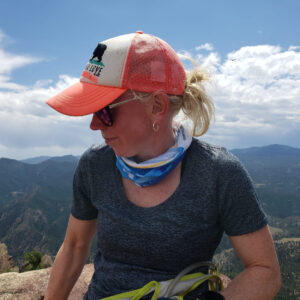By Kelly O’Mara
Note: We’re separating the issues around creating a course into two articles—one for smaller races and one for larger races. Today, we’re tackling creating courses for smaller events.
When small mom-and-pop races, as he calls them, come to Jim Gilmer for help with course creation, operational set-up, and logistics, they almost always have a general idea of what they want to do.
“It’s unusual to have no idea,” he said. Gilmer measures and certifies courses, as well as helps RDs with course design and operational set-up.
That means new would-be race directors typically have a park or a bridge or a popular loop or a finishing spot by a memorial, for example, in mind. They have some general idea in their head. What they need help with is how to firm that idea up, how to create a course in the real world, and knowing what issues to look out for.
Where are you going to start and finish?
Lyman Jordan, owner of Race Resources, which certifies and measures races and helps race organizers with race logistics, said the idea those race directors usually come to him with often is centered on the start and finish. For small races it’s typically optimal to start and finish in the same general area. Point-to-point races create added logistics for athlete transportation, parking, and gear.
A race that starts and finishes in the same general area can then be an out-and-back, a loop, or potentially a lollipop or keyhole course (meaning runners go out, loop, and then come back the way they went out).
The key to planning a start area is making sure you have enough room for the runners. While smaller races probably don’t need to worry about corrals and waves, it’s good to have a rough seeding plan (runners ahead of walkers) and know that an approximately 20-foot-wide road can have about 10 people across it. Does your start, then, have enough room for people to spread out before the first turn or before the course narrows?
“You don’t want people running over each other,” said Gilmer. Capacity of roads typically doesn’t become an issue until volume reaches about 500 athletes—but it’s something to keep in mind.
And then, along with the start line, you want to plan on space around your finish. Give runners room to decelerate and continue moving out of the way after the finish, have that movement lead them to the refreshments, and if you’re planning other post-finish festivities then build that into your course map and layout.
Where are you going to run from there?
Once you know, generally, where you want to start and finish, it’s helpful to plot out a rough course online using MapMyRun or any of the online mapping apps. “It usually isn’t accurate,” said Gilmer, but it provides an initial footprint.
That’s not the end, though! You can’t just grab a route off Strava and say job done.
“All the online tools are woefully inadequate,” said Jordan. GPS generally over-reads the mileage—ie. a 5K course on your watch will actually work out to 2.8 or 2.9 miles once officially measured. That’s because (not to get into the weeds) measurement of road running courses has to measure the shortest possible route from point to point, taking the straight line tangents through every curve. If you plot out online something that’s more like 3.3 miles, said Jordan, then you’re more likely to be able to get an actual 5K measured out of it—and leave some flexibility to move your start or finish to get the right distance once measured.
Where should you plot your course? For small races, of 200-500 athletes, parks and bike paths can be ideal because they don’t require road closures or traffic impacts. The downside is that most parks won’t allow you to fully close paths or trails for an event, because they’re public spaces. That means athletes will have to share the course with everyone else.
The next best place for smaller races: neighborhood streets, where you don’t have to impact any major roads. Major road or intersection closures increase your need for police and staff, which increase your costs exponentially. It also increases the planning required, because you’ll need to come up with a traffic plan, submit diagrams showing how you’ll direct runners and cars, where cones will be placed, and how emergency services will access the route. Large traffic impacts and street closures can get very complicated very quickly, which is why both Jordan and Gilmer advise smaller races to stay away from large road closures. (These issues also arise if your route is going to cross or close down bus stops, parking lots, or entrances to major stores or buildings—church being a key one on Sundays.)
A combo of parks, bike paths, and neighborhood streets usually works best for small events “if it’s low-key,” said Jordan.
A few things to keep in mind as you plan your route:
– Try to avoid loops for shorter races, because athletes will cross each other and it’ll complicate timing.
– At the start, try not to have athletes cross the finish line—especially if you’re using chip timing.
– Keep it simple.
– It’s also nice to have the harder or hillier parts be in the middle, said Gilmer, not right at the start or right at the end.
– And make sure someone is in charge of going out there race morning and checking that the course is set-up exactly how it’s supposed to be. If your course, for example, requires that athletes stay in the shoulder of a road or take a coned route around a turn in order to get the full distance, then those cones need to be set exactly where they’re supposed to be.
What permissions do you need?
In most towns, the local police or city officials are the place to start. Gilmer recommends taking your preliminary route to them and getting their recommendations. “Let them tell you what works,” he said—because they’ll have concerns and ideas, like where are you going to station medical assistance or how will emergency crews access the race if there’s a problem.
Then, you’ll likely have to get permits or approvals from wherever you’re hosting the race. That could be a simple event park permit or working with the city on transportation approvals if you’re crossing roads or intersections. Think through each of the agencies that govern where your race goes.
Jordan typically requires all permits and approvals are issued before he gets out there and measures and certifies the course—because you don’t want to have to start that process all over again if something has to change.
Do you need your course to be certified?
We’ve all had that argument: Some runner finishes their race and gets upset, ‘your course was too long, my GPS says.’ See above re: how courses are measured. But the only way to really confirm to them that your course is accurate is to have it officially measured. “It’s truth in advertising,” said Jordan. (Check out an article by an experienced certifier for more details.)
Pricing for course measurement and planning depends on size and complexity. Jordan charges approximately $750 for a mom-and-pop 5K and provide up-to-date color-coded maps that can be used for permitting and official purposes. Certification is then just a little bit more paperwork and another $30-50 or so, he said, but it provides a guarantee to athletes that your course is legitimate and certification could attract more runners—especially those who want some certainty they’re running a full 5K distance. He recommends it for all but the smallest of races.
(Measurement still requires a complicated manual process involving calibrating a tool and then riding a bike across the shortest line possible from apex of turn to apex of turn. You can find certified course measurers on USATF’s website.)
Of course you don’t have to get measured or certified, said Gilmer. Plotting the route, following the shortest line from point-to-point, on Google Earth can be quite tedious but fairly accurate, too.
The challenge, though, is “someone might set a record at one of your events,” he said—and if it’s not officially measured and certified, then the results won’t officially count in records or rankings. And every measurer has a story about some age-group record being set at a local race and then taken away because the course wasn’t accurate. And you don’t want that to be at your event.
About the Author
 Kelly O’Mara is the former editor-in-chief of Triathlete Magazine and the founder of the Triathlonish
Kelly O’Mara is the former editor-in-chief of Triathlete Magazine and the founder of the Triathlonish

